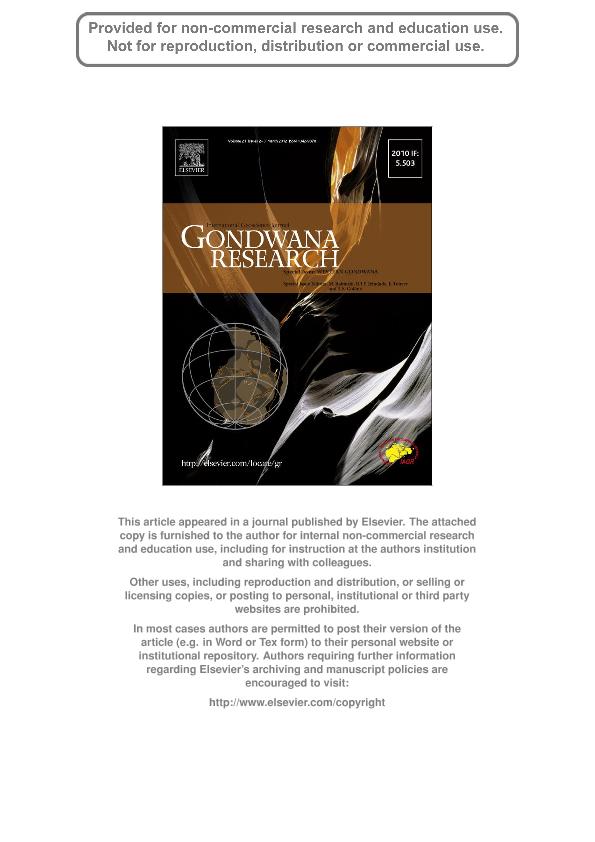Artículo
Identification and isotopic studies of early Cambrian magmatism (El Carancho Igneous Complex) at the boundary between Pampia terrane and the Río de la Plata craton, La Pampa province, Argentina
Chernicoff, Carlos Jorge ; Zappettini, Eduardo Osvaldo; Santos, João O. S.; Godeas, Marta Carmen; Belousova, E.; McNaughton, Neal J.
; Zappettini, Eduardo Osvaldo; Santos, João O. S.; Godeas, Marta Carmen; Belousova, E.; McNaughton, Neal J.
 ; Zappettini, Eduardo Osvaldo; Santos, João O. S.; Godeas, Marta Carmen; Belousova, E.; McNaughton, Neal J.
; Zappettini, Eduardo Osvaldo; Santos, João O. S.; Godeas, Marta Carmen; Belousova, E.; McNaughton, Neal J.
Fecha de publicación:
03/2012
Editorial:
Elsevier Science
Revista:
Gondwana Research
ISSN:
1342-937X
Idioma:
Inglés
Tipo de recurso:
Artículo publicado
Clasificación temática:
Resumen
We have identified late Early Cambrian metaigneous rocks very poorly exposed at the Estancia El Carancho, in central La Pampa province, Argentina. They comprise calc-alkaline metadiorite and metagranite, and tholeiitic metapyroxenite and metagabbro. They are jointly referred to as the El Carancho Igneous Complex, and regarded to pertain to the Pampean magmatic arc and backarc, respectively. Titanite U-Pb SHRIMP dating of the metapyroxenite yielded 528±5Ma, and zircon U-Pb SHRIMP dating of the metadiorite yielded 520±1.4Ma. Hafnium isotope determinations on the dated zircons show 176Hf/177Hf ratios corresponding to positive εHf values from +7.18 to +9.37; Hf model ages of the Cambrian zircons yielded 884Ma. It is interpreted that the metadiorites of the Complex crystallized from an Early Neoproterozoic (Tonian) juvenile source. We argue that the inferred occurrence of juvenile Tonian magmatic rocks in the (otherwise, mostly Paleo-Mesoproterozoic) substratum of the southern Pampia terrane could indicate a zone of thinned basement possibly associated with the early stage of Rodinia's breakup. In addition, the studied segment of the Pampean magmatic arc is contaminated by also juvenile, Late Mesoproterozoic crust, as evidenced by the presence of xenocrystic cores of 1140-1194Ma - TDM-Hf 1720Ma and εHf values of +3.24 to +4.85 - in the Cambrian zircons, hence suggesting that the studied segment of the Pampean magmatic arc was intruded into juvenile Late Mesoproterozoic magmatic arc rocks. The El Carancho Igneous Complex would be located at the tectonic boundary between the Pampia terrane and the Río de la Plata craton. This boundary stands out in the aeromagnetic data as a change in the structural orientation about a roughly N-S line located approximately at 65° W and representing the suture zone between the Pampia terrane and the Río de la Plata craton. Our geotectonic model envisages westward dipping subduction of oceanic crust beneath the Pampia terrane; the El Carancho Igneous Complex would, therefore, have been originated on the Pampia side (upper plate) of the suture. Slivers of the arc- and backarc-type rocks would have been tectonically imbricated in the suture zone during the Pampean orogeny.
Archivos asociados
Licencia
Identificadores
Colecciones
Articulos(SEDE CENTRAL)
Articulos de SEDE CENTRAL
Articulos de SEDE CENTRAL
Citación
Chernicoff, Carlos Jorge; Zappettini, Eduardo Osvaldo; Santos, João O. S.; Godeas, Marta Carmen; Belousova, E.; et al.; Identification and isotopic studies of early Cambrian magmatism (El Carancho Igneous Complex) at the boundary between Pampia terrane and the Río de la Plata craton, La Pampa province, Argentina; Elsevier Science; Gondwana Research; 21; 2-3; 3-2012; 378-393
Compartir
Altmétricas



